
While hydroponics offers a fantastic way to grow plants with greater control and efficiency, it’s not without its unique challenges. One of the most serious threats to a thriving hydroponic garden is root rot. This destructive disease can quickly spread and hinder your plants’ ability to absorb water and nutrients, leading to stunted growth, wilting, and even plant death.
Understanding the causes of root rot is the first step in preventing this devastating problem. Unlike traditional soil-based gardening, hydroponic systems create a specific environment where roots are constantly submerged in water. This makes them particularly susceptible to root rot if certain conditions arise.
Let’s delve into the primary culprits behind root rot in hydroponics. By understanding these causes, you’ll be better equipped to protect your hydroponic plants and maintain a healthy, thriving system.
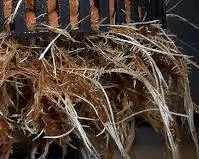
Primary Causes of Root Rot in Hydroponics
Fungal Pathogens (primarily Pythium)
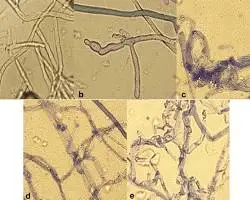
- One of the most common culprits behind root rot in hydroponics is a group of water-borne fungi, particularly Pythium. These microscopic pathogens thrive in moist, oxygen-poor environments, making hydroponic systems an ideal breeding ground. Pythium attacks plant roots, causing them to turn soft, brown, and mushy. As the infection spreads, the roots lose their ability to absorb nutrients, leading to the decline of the entire plant.
Insufficient Oxygen
- Roots, just like any other living tissue, require oxygen to function properly. In a hydroponic setup, dissolved oxygen in the nutrient solution is essential for healthy root development. Low oxygen levels can be caused by inadequate aeration, stagnant water, or overcrowding of plants, which restricts root space. When deprived of oxygen, roots become stressed and more susceptible to pathogens like Pythium.
High Water Temperatures
- Water temperature plays a crucial role in dissolved oxygen levels. Warm water holds less dissolved oxygen than cooler water. When water temperatures consistently exceed the optimal range of 65-75°F (18-24°C), it creates an environment where roots are oxygen-deprived, and pathogens can flourish.
Contaminated Equipment and Nutrient Solution
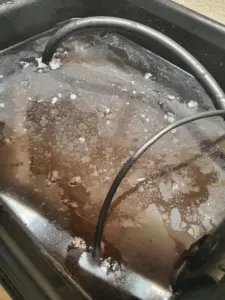
- Maintaining a clean hydroponic system is crucial. Fungal spores and other pathogens can be introduced through contaminated tools, reservoirs, or water sources. Dirty equipment provides a perfect environment for pathogens to multiply, increasing the risk of infection for your plants
Identifying Root Rot
Early detection is crucial in managing root rot and preventing it from spreading throughout your hydroponic system. Here are the telltale signs to watch out for:
Visual Symptoms:
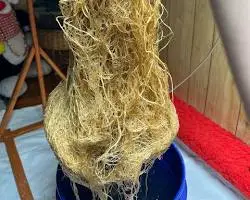
- Discoloration: Healthy roots are typically creamy white, sometimes with a slight tint from the nutrient solution. Infected roots develop a brown or black discoloration that starts at the tips and spreads upwards.
- Texture: Healthy roots are firm and slightly pliable. Rotting roots become mushy, slimy, and may disintegrate easily when handled.
- Foul Odor: As root rot progresses, you may notice an unpleasant, earthy smell coming from your nutrient solution or the root zone.
Plant Decline:
- Unfortunately, the damage caused by root rot often becomes apparent in the above-ground parts of your plants:
- Wilting: Even with adequate watering, leaves may wilt as the damaged roots cannot supply enough water.
- Yellowing leaves: Nutrient deficiencies occur as roots can’t absorb essential elements, leading to yellow or discolored foliage.
- Stunted Growth: New growth slows or stops altogether as the plant struggles to survive.
- Plant Death: In severe cases, the plant may collapse and die due to systemic infection.
Important Note: While these symptoms are strong indicators of root rot, they can also signal other problems like nutrient deficiencies or environmental stress. Therefore, it’s always crucial to examine the roots directly to confirm a root rot diagnosis.
Prevention Strategies for Root Rot
The best way to deal with root rot is to prevent it from taking hold in the first place. Focus on these key strategies to create an environment that promotes healthy root growth and minimizes the risk of infection:
Oxygenation:
Air pumps and air stones:
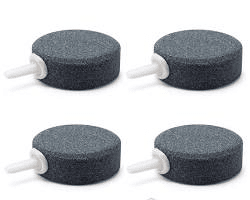
- These are incredibly effective at dissolving oxygen into your nutrient solution, particularly for systems like Deep Water Culture (DWC). Air stones create fine bubbles, increasing the surface area for oxygen exchange.
Water circulation:
- In systems like Nutrient Film Technique (NFT) or ebb-and-flow, ensure proper water flow. This movement continuously replenishes oxygen around the roots.
Water Temperature Control:
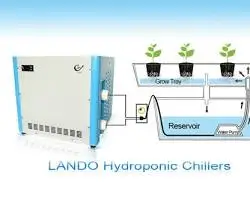
Ideal Range:
- Aim to maintain a water temperature between 65-75°F (18-24°C) for most hydroponic plants. This range maximizes dissolved oxygen levels.
Water Chiller:
- If your ambient temperatures are consistently high, consider investing in a water chiller to maintain the optimal temperature range.
Sanitation:
Cleaning Protocol:
- Thoroughly clean all hydroponic equipment (reservoirs, tubing, pumps, net pots) with a disinfecting solution between growing cycles. This prevents pathogens from lingering and infecting new crops.
Tool Sterilization:
- Sterilize all tools like scissors and measuring equipment before and after use to avoid cross-contamination.
Nutrient Solution Management:
Regular Monitoring and Changes:
- Regularly change your nutrient solution according to the plant’s needs and the system’s requirements. This helps prevent the buildup of salts and organic matter that can provide a food source for pathogens.
pH Management:
- Proper nutrient solution pH is critical for nutrient uptake and suppressing certain pathogens.
Beneficial Microbes:
- Some growers proactively incorporate beneficial bacteria and fungi into their hydroponic systems. These beneficial organisms can outcompete harmful pathogens and boost root health.
Treatment Options
While prevention is paramount, it’s still possible to intervene and potentially save your plants if you spot root rot early. Here’s what you can do:
Early intervention:
- Isolate infected plants: Immediately remove any plants showing signs of root rot to prevent the spread to healthy plants.
- Prune affected roots: Carefully trim away any visibly infected roots with sterilized scissors.
- Change nutrient solution: Completely discard the old nutrient solution and replace it with a fresh, properly balanced solution.
- Clean the system: Thoroughly disinfect the reservoir, pumps, tubing, and any other equipment that came into contact with the contaminated solution.
Chemical Treatments (Use with Caution):
- Fungicides: There are commercially available fungicides specifically formulated for hydroponic use. Exercise caution when using these products, as they can have negative impacts on beneficial microbes and overall plant health. Always follow the product instructions carefully.
- Hydrogen peroxide: Diluted hydrogen peroxide can be used as a temporary treatment. It adds additional oxygen to the solution and has some anti-microbial properties. However, proceed cautiously as it can also damage beneficial organisms.
Important Considerations:
- Severity of Infection: In cases of severe root rot, where most of the root system is damaged, saving the plant may be impossible.
- Plant Resilience: Some plants are more tolerant of root rot than others. Consider the type of plant you’re growing when deciding on a course of action.
- Balancing Act: While chemical treatments can help fight the immediate infection, it’s essential to address the underlying causes that led to root rot in the first place. Otherwise, the problem is likely to reoccur.
To Sum it Up
Root rot presents a serious threat to the health of your hydroponic system, but understanding its causes is vital for both prevention and effective treatment. Proactive measures like prioritizing oxygenation, maintaining proper water temperatures, and practicing strict sanitation protocols will significantly minimize the risk of encountering this disease. By staying vigilant and observing your plants closely, you can spot issues early and take quick action if any signs of root rot appear.
Remember, maintaining a healthy hydroponic system is an ongoing process. Incorporating preventative strategies and being prepared to act decisively when problems arise will help ensure your hydroponic garden continues to flourish.
Listen, keeping plants alive can be a lot of work. But our friends at Lettuce Grow has taken a lot of the work out of it and given you the ability to just enjoy harvesting your crops. Check them out.
The Farmstand Is Your Self-Watering, Self-Fertilizing Solution for an Easy to Grow Harvest
FAQ
Q: Can my plants recover from root rot?
A: The possibility of recovery depends on the severity of the infection and how quickly you take action. If caught early, plants may regenerate new, healthy roots. However, severe cases can cause irreversible damage.
Q: How often should I clean my hydroponic system to prevent root rot?
A: Clean your system thoroughly between crop cycles to eliminate potential pathogens. Additionally, regular maintenance like rinsing growing media and checking for debris buildup will help maintain a healthy environment.
Q: Will adding an air pump always prevent root rot?
A: While increasing oxygenation is essential, it won’t solve every issue. Root rot can still occur due to high temperatures, contaminated solutions, or existing damage to the roots.
Q: Are some hydroponic systems more prone to root rot than others?
A: Yes. Systems where roots are constantly submerged in water, like Deep Water Culture (DWC), require extra emphasis on oxygenation and water temperature control as they are slightly more susceptible.
Q: Can beneficial bacteria completely eliminate the risk of root rot?
A: While beneficial microbes can help create a healthier root environment and suppress some pathogens, they don’t guarantee 100% protection against root rot. It’s still vital to maintain optimal growing conditions.

